When you’re learning or teaching someone to drive, where’s the first place you go? A parking lot. There’s plenty of space, the speed limit is low and there are lines to practice parking — it’s a safe space. Eventually, you’ll move up the chain to the dreaded highway, where things are much faster and, in theory, more dangerous. But for self-driving cars, it’s actually the opposite.
Matthew Johnson-Roberson, cofounder of Refraction AI, an autonomous vehicle startup, recently told Wired that “automated driving is effectively solved” on the highway. Anyone who has driven a Tesla with Autopilot knows this (some a little too well). Even though that feature isn’t full self-driving, it’s one of the closest consumer experiences available right now. And with the EV company’s new Smart Summon feature, which launched in beta in September, they’re now trying to solve the problem of the parking lot. But why is that seemingly safer area so much more difficult?
Wired recently took a look at the antithetical issue, and presents the problem this way: “In fact, parking lots are one of the most human places you could put a car that doesn’t need a human to drive. Their rules are not always consistent, and drivers, moreover, don’t always follow them. They’re full of little people-to-people interactions: a wave to let the dad behind the stroller [know] that you’re going to stop and let him cross; a nod to tell the other driver to inform him that you’re waiting for this woman fiddling with her keys to finally pull out of her spot. These are very complicated things for computer systems to learn, even if they’re trained on tons and tons of real-life parking lot data.”
Tesla’s Smart Summon feature, despite being widely available for less than two months, has already collected tons and tons of data. Last week, the company announced it had already been used over a million times. It works like this: Using the Tesla app, drivers can “enable their car to navigate a parking lot and come to them or their destination of choice, as long as their car is within their line of sight,” according to a press release.
The rollout has led to fantastical headlines claiming “havoc,” ridiculing it as “pointless” and dismissing it as a “total fail!” And of course, there is bound to be some failure and a tiny bit of havoc when testing new self-driving technology in the real world, which is essentially what Tesla is doing. But as Wired rightly notes, “… the company has captured 1 million maneuvers’ worth of data on weird parking lot happenings, and can use it to make its cars drive themselves around parking lots with more, well, confidence.”
While social media users are quick to “LOL” at Tesla fails and some outlets are quick to label the new feature as “pointless,” the company is gathering much more data than most people realize. And that may help the company beat everyone else to the self-driving finish line, or rather, the parking spot.
Subscribe here for our free daily newsletter.
Thanks for reading InsideHook. Sign up for our daily newsletter and be in the know.



















